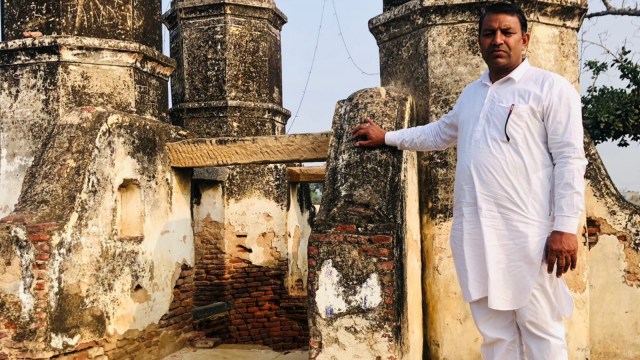From the 1857 rebellion to the present, a Haryana village’s long struggle for justice sees a ray of hope
Over 166 years later, Vinod Sharma, whose family lost its land in 1858 after rebelling against the British, is seeing a glimmer of hope for justice now, thanks to a fact-finding panel set up by Bhiwani deputy commissioner Naresh Narwal last year.
 The historical well in Rohnat village: Women from the village reportedly jumped into the well to save their honour when the Britishers entered the village in 1857. (Express Photo/special arrangement)
The historical well in Rohnat village: Women from the village reportedly jumped into the well to save their honour when the Britishers entered the village in 1857. (Express Photo/special arrangement)In village Rohnat, the scars of history run deep as residents strive to reclaim what was lost in the tumultuous past. The villagers, who rose against the British rulers in 1857 had to pay a heavy price for their rebellion. While many of them were hanged to death, others had to face road-rollers on a road that continues to be called the “lal sadak”. Those who survived lost their land when in 1858, the British rulers auctioned it for a paltry sum to neighbouring villagers to teach Rohnat natives a lesson.
Over 166 years later, Vinod Sharma, whose family lost its land in 1858 after rebelling against the British, is seeing a glimmer of hope for justice now, thanks to a fact-finding panel set up by Bhiwani deputy commissioner Naresh Narwal last year. Narwal, who had learnt about the tumultuous history of the village, has formed a team to search through old records pertaining to the village. Members of the panel, who include Rohnat villagers, have been digging into archives and revenue offices, looking for proof of the land auction.
Aditya Ranga, the Bhiwani tehsildar leading the team, admits it’s tough to find solid evidence in the scattered historical documents.
“We’re trying hard to find proof that the land was auctioned due to the revolt. We’ve found records mentioning the ‘sale’ of the land but not the actual auction. Hopefully, within a month, we’ll have better findings,” says Aditya.
The village history is a mix of bravery and sorrow. Chhaju Ram, Vinod’s ancestor, was one of the 52 villagers whose land was ‘auctioned’ as punishment after they rebelled in 1857. Vinod Sharma says, “Naunda Ram and Roopa Khati were hanged on the banyan tree while Birad Dass Swami was blown up by a cannon.”
According to a book published by villagers, residents of Rohnat and neighboring villages launched an assault on British officials in Hisar and Hansi on May 29, 1857, killing 12 British officials in Hisar and 11 British officials in Hansi. The book also mentions, “The revolutionaries even looted the government treasury and freed prisoners while breaking a jail. Then, Rohnat was destroyed with the help of artillery.”
Numerous villagers reportedly fell victim to British reprisals, with some crushed under a road-roller in Hansi and others hanged on the banyan tree that still stands near the 13-big jaw village pond that escaped auction.
Vinod Sharma recounted the fates of Naunda Ram, Roopa Khati, and Birad Dass Swami, vividly illustrating the violence inflicted on the villagers.
Former village sarpanch Renu Boora’s husband, Ravinder Boora, claimed that after Independence, Chief Minister of joint Punjab, Partap Singh Kairon, promised to allot alternative land to the villagers. Boora claims Kairon wanted to give 57 plots near Hisar, each spanning 12.5 acres, to the descendants of revolutionaries whose land was auctioned in 1858.
Boora’s ancestor, Sarbhu Boora, was among those whose land was auctioned.
Communications from 1966 between the deputy commissioner of Hisar and the additional chief secretary of Punjab indicate the government’s serious consideration of land allotment. However, despite efforts, the land wasn’t allocated. Instead, in 1970, the Bansi Lal government granted Rs 1.25 lakh as symbolic compensation to the descendants of 25 deceased freedom fighters from the village.
The unfulfilled promises left villagers dismayed, leading them to abstain from hoisting the national flag until 2017. It was only after meeting Chief Minister Manohar Lal Khattar in 2017 that changes began. The following year, Khattar visited Rohnat village, hoisted the national flag for the first time, and announced the establishment of the Rohnat Freedom Trust.
Boora mentioned that subsequent to the Chief Minister’s announcement, efforts have commenced to erect a war memorial and establish a library in the village. Additionally, plans include beautification around a well and a banyan tree adjacent to a village pond. Boora emphasized the historical significance of these landmarks, recounting how, in 1857, women leaped into the well to protect their honour, and revolutionaries were executed on the banyan tree.
Ravinder Boora also highlighted the ongoing challenges faced by the village, citing the misclassification of residential properties and land as part of neighboring villages instead of Rohnat. “The government must rectify this to restore the village residents’ honour,” he says.
Vinod Sharma, part of the team set up by the Bhiwani DC, shared documents showing that 4,315 acres of land in the village was sold for just Rs 8,100 in 1858. The villagers, he recounts, were excluded from the auction and stripped of government benefits.
Even after Independence, they managed to reclaim 700 acres, but the struggle continues as neighboring villages still farm the rest. The fight for justice began afresh in 1955 when Vinod’s grandfather and others started demanding the return of their land.
Almost seven decades later, Bhiwani deputy commissioner Naresh Narwal says he is doing his best to help the villagers by sifting through the old records so that the truth can come to the fore.













